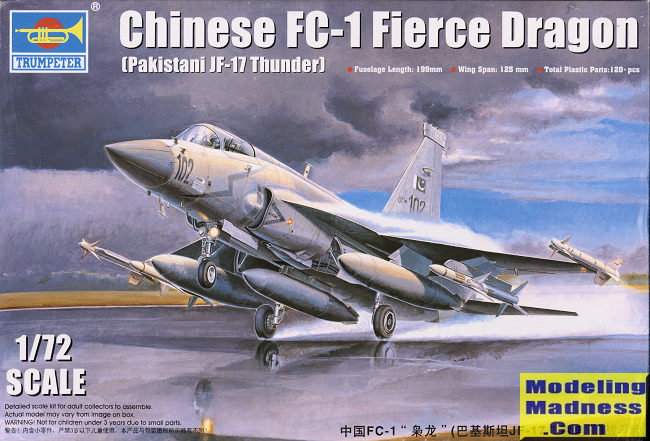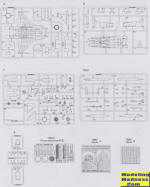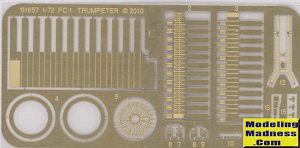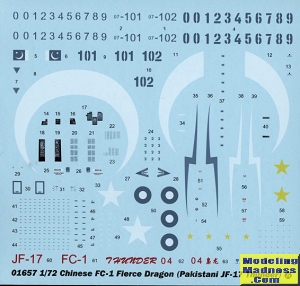
Trumpeter 1/72 FC-1 Fierce Dragon
| KIT #: | 1657 |
| PRICE: | $ |
| DECALS: | Three Options |
| REVIEWER: | Scott Van Aken |
| NOTES: | 2017 Boxing |

| HISTORY |
The JF-17 Thunder (Urdu: تھنڈر), also designated Chengdu FC-1 Xiaolong (English: Fierce Dragon; Chinese: 枭龙; pinyin: Xiāo Lóng) is a single-engine, light-weight multi-role combat aircraft developed jointly by the Chengdu Aircraft Industries Corporation (CAC) of China, the Pakistan Air Force and the Pakistan Aeronautical Complex (PAC). It is designated as "JF-17" by Pakistan, which is short for "Joint Fighter-17" and as "FC-1" by China, which is short for "Fighter China-1".
The JF-17 was developed primarily to meet the requirements of the Pakistan Air Force for a low-cost, medium-technology, multi-role combat aircraft as a cost-effective replacement for its ageing mixed fleet of Nanchang A-5, Chengdu F-7P/PG and Dassault Mirage III/V fighters and also have export potential to air forces of other developing countries as a cost-effective alternative to hi-tech but expensive Western fighters.[
Pakistan and China signed the Letter of Intent for the joint development of the JF-17 (then called "Super-7") in 1998, followed by the signing of the Contract in 1999. The project got delayed due to the inability to find an avionics and radar package. In 2001, the Pakistan Air Force recommended that the airframe design be de-coupled from the avionics and radar systems for the aircraft to avoid further delay. This resulted in a fresh impetus to the project and the design was finalized and 'frozen' in 2001. The maiden test flight of the first prototype took place during 2003 in China, later test flights with a modified design with Diverterless Supersonic Intakes (DSI), and a modified tail design took place in 2006. Deliveries to the Pakistan Air Force for further flight testing and evaluation began in 2007, the aircraft's first aerial display also taking place that year in Islamabad, Pakistan. The Pakistan Air Force officially inducted its first JF-17 squadron on 18 February 2010.
The JF-17 is expected to cost approximately US$15 million per unit. The Pakistan Air Force has announced that it has a confirmed order for 150 JF-17s, which may increase to 250 aircraft. The JF-17 will replace Pakistan's MiG-21-derived Chengdu F-7, Nanchang A-5 and Dassault Mirage III/Mirage V aircraft currently in service. Azerbaijan, Zimbabwe and eight other countries have expressed interest in purchasing the JF-17 at a recent military exhibition in Pakistan, according to an official.
| THE KIT |
 To
my knowledge, this is the first kit of this aircraft in 1/72 scale. Typical of
Trumpeter, the five grey and one clear sprue are nicely molded with all that
modern modelers expect. Two of the sprues are identical and dedicated to
ordnance, pylons and fuel tanks. Most of the fuselage is split horizontally with
the upper half including the wings. The nose section is split vertically with
the fin and tailplanes being separate.
To
my knowledge, this is the first kit of this aircraft in 1/72 scale. Typical of
Trumpeter, the five grey and one clear sprue are nicely molded with all that
modern modelers expect. Two of the sprues are identical and dedicated to
ordnance, pylons and fuel tanks. Most of the fuselage is split horizontally with
the upper half including the wings. The nose section is split vertically with
the fin and tailplanes being separate.
The cockpit has a full tub which accepts a five piece
ejection seat, stick and rudder pedals. There is a photo etch fret included with
the kit and part of this is for the seat harness. Like most modern kits,
Trumpeter wants you to completely build the nose gear before installing it in
the nose well, which then attaches to the
 underside of the cockpit assembly.
This is then trapped between the forward fuselage halves.
underside of the cockpit assembly.
This is then trapped between the forward fuselage halves.
Intake trunking leads to a blanking plate and, along with the instrument panel/anti-glare assembly, attaches to the forward fuselage. No weight is indicated, but I'd leave off the radome until I was sure none was needed. The two piece windscreen/canopy is then attached. You can pose the canopy open if you wish. More p.e. is used for mirrors.
The main gear wells are two pieces and each then attaches to the lower fuselage section after installing a brace. At this time, the upper fuselage and nose section are attached to each other. The rest of the p.e. is used for inside the exhaust. This is a somewhat complex build, but the instructions are very good in terms of how to assemble this. This item along with the fin and stabs are then attached to the airframe.
Next part of the build deals with the main gear, gear doors,
wing pylons and the centerline gun. There are two styles of fuel tanks provided,
one for the centerline and two for wing pylons. The other items for the pylons
are what appear to be Sparrow and Sidewinder missiles. These missiles have
separate fins. There is a loadout diagram to show where everything goes.

Instructions are well done and provide a fair amount of interior painting information, but do leave out things like intake interiors, main gear colors and main well information. If one assumes these are the same as the nose gear, then gear is silver and wells are Intermediate Blue. The decal sheet has three options. Two are Pakistani JF-17s with one in standard greys and the other in a very colorful special scheme of red, white, and green. The other is a Chinese prototype in greys. Decals are well done and you are provided with a nice selection of numbers for the grey Pakistani aircraft. There are aftermarket decals, though I only know of one sheet by Caracal Models and it may be out of production.
| CONCLUSIONS |
Those who have a penchant for modern fighter aircraft should seriously consider picking this one up. It appears that it will make a very nice model when done and will add some interest to your display shelves.
| REFERENCES |
http://en.wikipedia.org/wiki/JF-17_Thunder
July 2020
Copyright ModelingMadness.com. All rights reserved.
If you would like your product reviewed fairly and quickly, please
contact
the editor or see other details in the
Note to
Contributors.